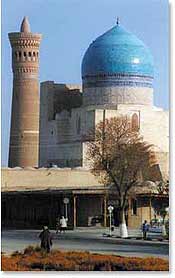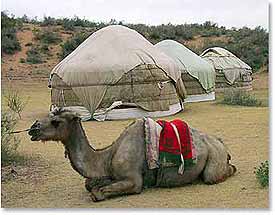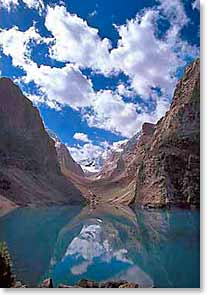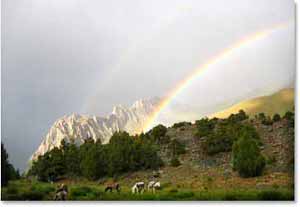
Treasures of the Silk Road – Trip Itinerary
Day 1 - Depart Home Country
Day 2 - Arrive in Tashkent, Uzbekistan. Welcome at the airport and transfer to our first-rate hotel.
 Day 3 - Explore the surprising and exciting Tashkent, the largest city of Central Asia and the third largest in the Commonwealth of Independent States (eleven of the republics of the former Soviet Union). Our hotel will be near Amir Timur Square, where the imposing statue of 13th century warlord Tamerlane has replaced busts of Lenin, Stalin, and Marx and announced with clarity the renewed national pride of Uzbekistan. We will join locals in the cafes and shops of nearby Sayilgokh Street, recently renamed “Broadway” because of its commercial bustle. The city’s beautiful and efficient Metro system will serve as our transportation to other parts of Tashkent, We should have time to visit the National History Museum and the Fine Arts Museum where we’ll see traditional Uzbek silks, gold embroidery, wood carving and ceramics.
Day 3 - Explore the surprising and exciting Tashkent, the largest city of Central Asia and the third largest in the Commonwealth of Independent States (eleven of the republics of the former Soviet Union). Our hotel will be near Amir Timur Square, where the imposing statue of 13th century warlord Tamerlane has replaced busts of Lenin, Stalin, and Marx and announced with clarity the renewed national pride of Uzbekistan. We will join locals in the cafes and shops of nearby Sayilgokh Street, recently renamed “Broadway” because of its commercial bustle. The city’s beautiful and efficient Metro system will serve as our transportation to other parts of Tashkent, We should have time to visit the National History Museum and the Fine Arts Museum where we’ll see traditional Uzbek silks, gold embroidery, wood carving and ceramics.
Late in the day we can purchase beautiful loaves of bread that Uzbek women proudly display in their market stalls. As we depart on the night train to Bukhara, the bread will be a tasty reminder of our time in Tashkent.
Day 4 - Our first stop along the Silk Road will find us awakening in Bukhara with the sense we have come through a time warp into an earlier age. Once an important hub of Central Asian learning, commerce, and religion, Bukhara was destroyed in the 13th century by Genghis Khan. Much remains of the cultural heritage, offering us a window into the past.
 Our hotel in the heart of old Bukhara is within walking distance of the Registan and the Ark Fortress. Architecturally complex, the structures are reminders of Bukhara’s rich and violent past. Arabs built the first mosque here on the ashes of a Zoroastrian temple in 713 AD. Over the centuries a succession of rulers including Turks, Uzbeks, and followers of Genghis Khan gave shape to the culture of Bukhara. In more recent times Russian influence has been profound, but seems transient against the full context of history. The city is filled with fine Islamic architecture.
Our hotel in the heart of old Bukhara is within walking distance of the Registan and the Ark Fortress. Architecturally complex, the structures are reminders of Bukhara’s rich and violent past. Arabs built the first mosque here on the ashes of a Zoroastrian temple in 713 AD. Over the centuries a succession of rulers including Turks, Uzbeks, and followers of Genghis Khan gave shape to the culture of Bukhara. In more recent times Russian influence has been profound, but seems transient against the full context of history. The city is filled with fine Islamic architecture.
Day 5 - Today we drive into the desert. In the village of Gijduvan not far from Bukhara we will visit our friend Abdullo Narzullaev, a sixth-generation master potter practicing the world-famous traditions of the Gijduvan school of ceramics. We enjoy taking tea with the Narzullaev family and visiting the kilns and pottery shop. Hanging on the walls are photographs of some of Gijduvan’s guests including Hillary Clinton, Prince Charles, and Madeline Albright.
From Gijduvan we will journey deeper into the desert to spend the night at a yurt camp. As the sun sets and the evening begins cool, we can take a short camel ride around a quiet village near our camp.
Day 6 - Our drive continues toward the fabled city of Samarkand. On the way we will spend time in Nurata, a small town of amazing historical and spiritual significance. Alexander the Great built a fortress here in the design of a celestial plough, symbolizing the strength needed for his upcoming siege of Samarkand. We will also visit the holy waters of Chashma where pilgrims will be collecting water and feeding the thousands of fish that have found a home in the clear waters of the spring. Evening will find us settling in for the next two nights at our hotel centrally located in Samarkand.
 Day 7 - Marco Polo reported that Samarkand was “one of the most perfectly beautiful cities in the world.” It has also been tossed about in the turbulence of struggles for domination by Alexander the Great, Genghis Khan, and Tamerlane, who made it the capital of an empire that stretched from India to Turkey. In recent times the Soviets held sway here. The Bolsheviks first flew their red banner of revolution in Central Asia over Samarkand in 1917.
Day 7 - Marco Polo reported that Samarkand was “one of the most perfectly beautiful cities in the world.” It has also been tossed about in the turbulence of struggles for domination by Alexander the Great, Genghis Khan, and Tamerlane, who made it the capital of an empire that stretched from India to Turkey. In recent times the Soviets held sway here. The Bolsheviks first flew their red banner of revolution in Central Asia over Samarkand in 1917.
With a full day before us, we will make the most of learning firsthand about the wonders of Samarkand. Our opportunities range from visiting Ulug Beg (the Astronomer King’s Observatory) to wandering bazaars in continuous operation for 2500 year. The hours will fill as quickly as our notebooks, cameras, and minds.
Day 8 - In the morning we will begin the 65 kilometer drive to Pendjikent in the Republic of Tajikistan where our trek staff, cook and porters will meet us. If we have time along the way, we can visit the ancient site of the pre-Islamic Sogdian confederacy, discovered by archaeologists in 1933. In Pandjikent our staff will see to the trekking permits and environmental fees, then after lunch we will transfer to four-wheel-drive vehicles for the short, scenic journey to the Artuch Base Camp at an elevation of 7,200 feet (2,200 meters). We will roll out our sleeping bags in the camp’s two-room cottages and will make the most of the saunas and showers to wash off the dust of the road.
 Day 9 - The trekking portion of our Silk Road adventure begins with a walk through juniper forests toward the glacial features of the mountains above. We’ll step to the edge of the trail to allow Tajik children to pass as they accompany their parents to gather firewood in the forest that they will carry home on the backs of their donkeys. By afternoon we will be surrounded by the fabulous alpine scenery of the Fann Mountains. Clear streams, turquoise lakes, and magnificent jagged peaks are all around. Our camp for the night will be near Kulikalon Lakes at an elevation of 9,500 feet (2,900 meters).
Day 9 - The trekking portion of our Silk Road adventure begins with a walk through juniper forests toward the glacial features of the mountains above. We’ll step to the edge of the trail to allow Tajik children to pass as they accompany their parents to gather firewood in the forest that they will carry home on the backs of their donkeys. By afternoon we will be surrounded by the fabulous alpine scenery of the Fann Mountains. Clear streams, turquoise lakes, and magnificent jagged peaks are all around. Our camp for the night will be near Kulikalon Lakes at an elevation of 9,500 feet (2,900 meters).
Day 10 - Tajik herders living in animal skin huts called kappas will accompany us and use their donkeys to carry some of our loads. The walk on Day 10 takes us through dramatic terrain to cross a mountain pass at 12,400 feet (3,800 meters). The scenery will be breathtaking and the day will be demanding. We’ll have lunch in a beautiful grassy area below the pass, then descend to 9,500 feet (2,900 meters) where we will find our camp at Aluddin Lake..
Day 11 - During a walk of about five miles we will gain 2,400 feet (750 meters) in elevation. No doubt our down jackets and other warm gear will start to come in handy
The Fann Mountains have a very Asian feel. The same Himalayan Snowcocks found in Nepal, for instance, are often seen here. With high, stunning peaks rising all around us, our camp will be on the shores of beautiful Mutnoje Lake at 11,800 feet.
Day 12 - The conditioning and acclimatization that we have gained in the preceding days will serve us well as a three-mile hike takes us up another 3,000 vertical feet to rugged Chimtarga Pass. The route ascends alongside a glacier to a trail switchbacking up a final rocky slope. At an elevation of 14,700 feet (4,480 meters), our camp near the pass is a true mountaineers’ nest. It is here that the Zeravshanskiy range converges with the Gissarskiy range. The Fann Mountain panorama all around us is a spectacular feast for the eyes and the soul. You might not master the exact pronunciation of the names of all the peaks, but you will never forget them!
 Day 13 - Hot beverages and a good breakfast will energize us as we bid farewell to our high alpine camp and head over the Chimtarga Pass. Superb scenery and unforgettable landscapes continue to envelope us, and so does the adventure of trekking. The initial descent from the pass will be exhilarating and challenging as we use a short fixed rope for added safety. We’ll soon be back on a good trail for easy walking down to Balshoje Allo Lake at an elevation of 10,100 feet (3100 meters). The result of a 1916 landslide, Balshoje Allo may well be among the world’s beautiful alpine lakes.
Day 13 - Hot beverages and a good breakfast will energize us as we bid farewell to our high alpine camp and head over the Chimtarga Pass. Superb scenery and unforgettable landscapes continue to envelope us, and so does the adventure of trekking. The initial descent from the pass will be exhilarating and challenging as we use a short fixed rope for added safety. We’ll soon be back on a good trail for easy walking down to Balshoje Allo Lake at an elevation of 10,100 feet (3100 meters). The result of a 1916 landslide, Balshoje Allo may well be among the world’s beautiful alpine lakes.
Day 14 - The amazing topography of the Fann Mountains continues to impress us as we trek back into the lowland forests. The landslide that created Balshoje Allo also imprisons the Zindon River that flows from the lake, hiding it underground until it emerges far down the valley. As we hike we will see more and more Tajik shepherds. Our camp will be below 6,000 feet in elevation (1,800 meters).
Day 15 - After saying goodbye to our Tajik trekking staff and taking care of the formalities at the border to reenter Uzbekistan, our drive to Samarkand should take us no more than about five hours. We’ll pass the time visiting about our adventures and anticipating the showers, meals, and other comforts we’ll enjoy when we reach our Samarkand hotel.
Day 16 - There will be time in the morning for last-minute sightseeing and shopping near our hotel in Samarkand. The drive to Tashkent has us arriving in time to settle in for the evening.
Day 17 - Departure day from Tashkent. Depending on your destination and flight schedule, this might also be the day your reach your home.
Day 18 - Home arrival for most trans-Atlantic travelers.

